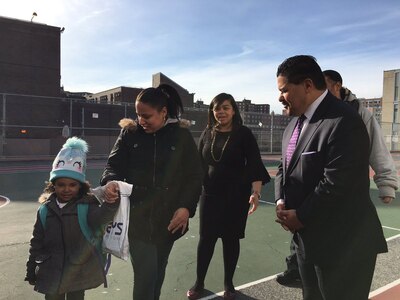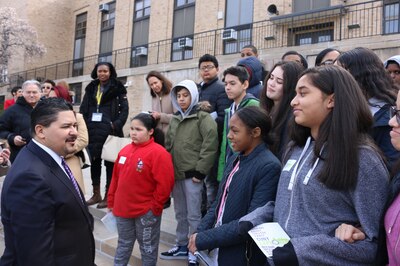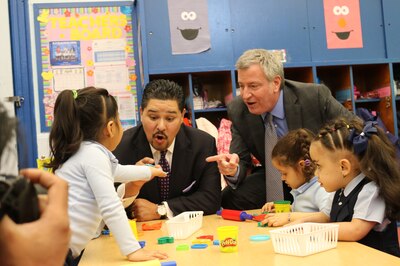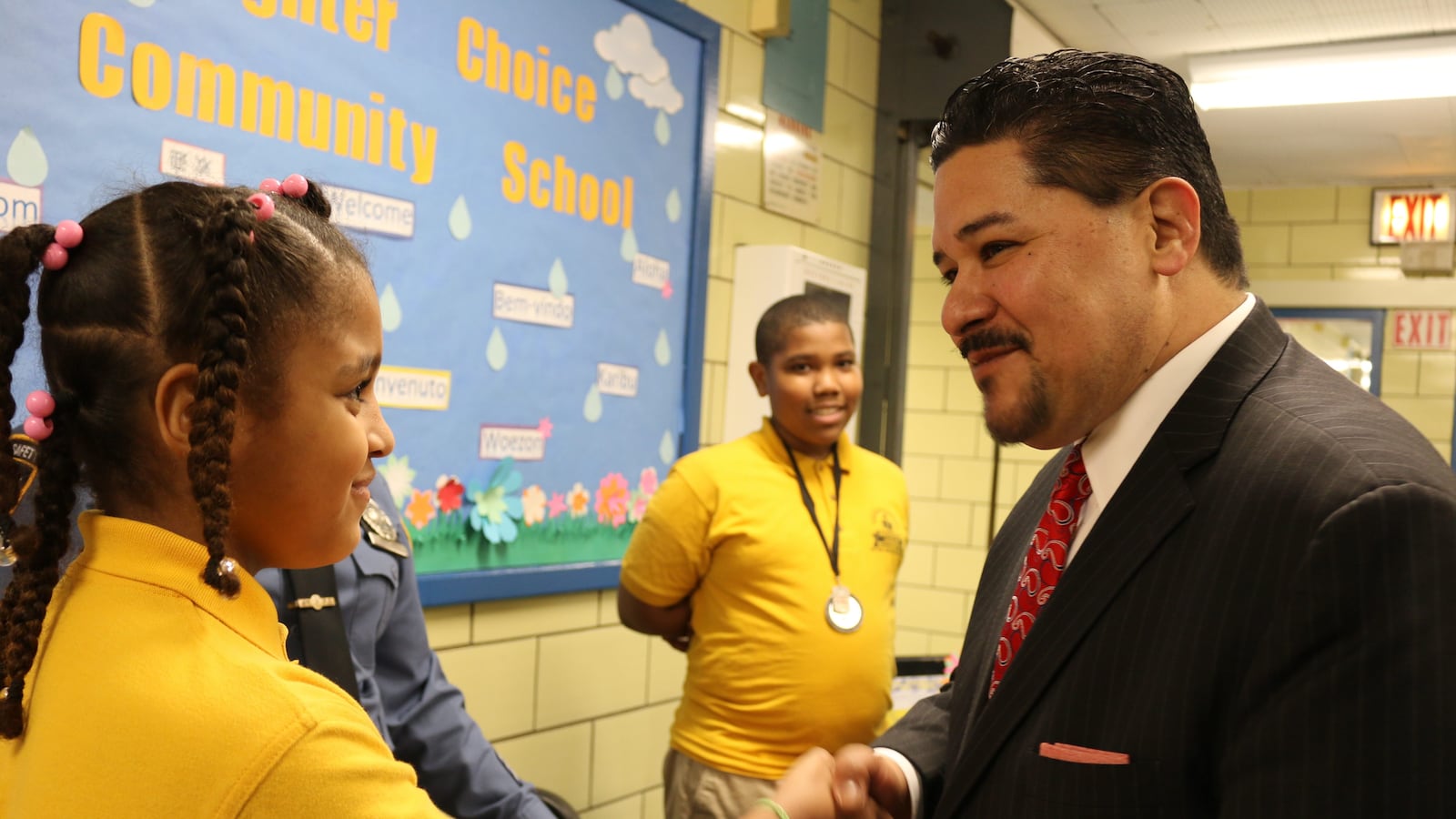Chancellor Richard Carranza is spending his second week in New York City visiting city schools — a lot of them.
On Monday, he headed to the Bronx to visit three schools. Tuesday, he’s stopping by three more, this time in Brooklyn. And he’s expected to keep the tour up the rest of the week.
The visits are just one part of the Department of Education’s public introduction of Carranza to the city. On Monday, the DOE also released the first part of a video interview series, in which Carranza emotionally talks about walking his parents around his college campus.
Chalkbeat reporters Alex Zimmerman, Christina Veiga and Monica Disare will be along for the ride in the education department’s bumpy press van and will share dispatches here. Stay tuned for updates.
Monday, April 9
7:36 a.m. Many chancellors have done five-borough tours on their first days of school. Carranza plans to stretch his tour out all week, Alex reports from Tweed, where he’s about to get on the press van to Concourse Village.
That’s no small feat: It’s a challenging week for school visits, because elementary and middle schools will be administering state testing starting on Wednesday.
8:45 a.m. Carranza is at Concourse Village Elementary School now. Located in District 7 in the Bronx, one of the most struggling districts in the city, the school it has won accolades for making both academic gains and addressing students’ social and emotional needs, a de Blasio administration priority. According to Insideschools, graduates are increasingly sought by area middle schools — including M.S. 223, the school that Carranza’s predecessor, Carmen Fariña, visited on her first day as chancellor.
8:55 a.m.
9:02 a.m.
9:30 a.m. At Concourse Village Academy, Carranza visited kindergarten, pre-K, and 3-K classrooms.
Carranza was mostly quiet during the initial classroom visits — he did not pepper the principal, students or teachers with questions, something that had become a hallmark of his predecessor. “I’m in fact-finding mode,” he later told reporters. “I’m looking with a very non-prejudiced eye and just taking it in.”
Carranza sang and danced along with pre-K students who were learning about different parts of plants through a song called “I’m a Little Daisy.”
Carranza touted the city’s investments in early childhood education — the expansion of pre-K has been a signature accomplishment of Mayor de Blasio.
“It’s one of those game-changer initiatives,” he said, noting “you have to wait a little bit to see the results.”

Carranza said Concourse Village was chosen for his first visit partly because of its geography: It is a high-performing school, but it is nestled in one of the city’s poorest regions and many other schools in the district struggle.
“It’s no mistake that I’m here this morning,” he said.
Asked about the city’s homelessness crisis — roughly one in 10 students live in temporary housing – Carranza said he is interested in talking about the problem with advocates from around the city.
“I will absolutely be sitting down and working with whomever is at the table,” he said. (Still, the mayor has taken criticism from advocates who were upset that he did not include funding for additional social workers in his original budget proposal.)
Answering questions from reporters, Carranza said he is interested in addressing the city’s achievement gap, and mentioned school segregation by name — something both the mayor and former-Chancellor Fariña had avoided.
He said he spent much of his first week being briefed on policy issues and meeting his new co-workers at Tweed.
“Last week I spent all of my time really diving into the policy issues and bringing myself up to speed,” he said.
10 a.m.

Carranza’s next stop is a tour of Bronx Community College with a group of 7th graders from PS/MS 279, as part of College Access for All. The initiative, founded under Mayor de Blasio, helps school build a culture around college and careers.
Three hundred fifty-five middle schools are participating in the program this year across 21 districts, according to Raana Kashi, a college access for all program manager. It will be in all middle schools across the city next year
The middle schools in the program get extra funding to help students start thinking about college, including these college visits.
“This should be how you feel comfortable” Carranza said of the college campus.
“If I can do it, you can absolutely do it,” he told the students during the tour Monday.
11:30 a.m.

De Blasio and Carranza channeled their inner children at PS 25 The Bilingual School. They squeezed into tiny tables and played with Play-Doh and food from a toy kitchen as they chit-chatted with the youngsters.
P.S. 25 was among the first schools in the city to take advantage of the mayor’s push for pre-K for all three-year-olds. In brief remarks to reporters, de Blasio said pre-K is becoming a “universal right.”
“This is the foundation of creating a whole generation of lifelong learners,” the mayor said. “This is a brand new reality.”
Still, the city faces an uphill climb before all three-year-olds are eligible for free pre-K. The city anticipates that it won’t happen until 2021, a much slower rollout than the rollout for all city 4-year-olds. And expanding universal pre-K to include 3-year-olds is expected to require $700 million from state and federal sources by 2021 during a time when the state faces a $4.4 billion funding gap and a federal tax overhaul could create tighter school budgets.
Last week, the mayor suggested that Carranza would “supercharge” his universal literacy initiative designed to get students reading on grade level by the third grade.
For his part, Carranza said the benefits of universal pre-K might not accrue immediately, but that he expects long-term benefits from the program — including in reading.
“When these students get to the third grade I can assure you they will be reading on grade level,” Carranza said.
Tuesday, April 10
8:45 a.m. Chancellor Richard Carranza started his second day of school tours at Brooklyn Studio Secondary school in the Bath Beach neighborhood. He kicked off the visit by helping Principal Andrea Ciliotta with morning announcements. “Let’s have some joy in school! Are you with me?” he asked over the public address system, drawing some cheers from students.
9:13 a.m.
9:23 a.m.
Carranza has made college access and preparedness a talking point over the last two days. On Monday, he went on a tour of a college with students. And Tuesday, he attended a college advisory class. “Remember, it’s got to feel like home. And remember you can do it,” he told students.
9:32 a.m.
It’s no secret that music has played an important part in Carranza’s life — he’s an accomplished mariachi musician and has played music with students. So of course he attended a band class Tuesday morning. Unfortunately, much to the dismay of reporters, Carranza didn’t pick up an instrument. He did meet a student with the same last name who plays the same instrument that he did in high school — the baritone sax. “Are we cousins?” he joked.
10 a.m.
Carranza said he plans to make a habit of his school visits, squeezing in at least one a week — or more.
“I just think it’s really critically important to have the DNA of school. The only way to do that is to just walk into a building,” he said. “When I moved into a central office role, I’ve always wanted to stay connected to what really happens in schools.”
He also said he’s been known to follow around a student for a day. (Though, after throwing an opening pitch at a high school baseball game Monday afternoon, Carranza joked he’ll probably avoid joining students for baseball practice until he can improve his arm.)
“We as adults make lots of decisions for students, but it is so informative when we hear from students what it actually is that they want and what they need.”
He called College Access for All a “game-changer.” Earlier, he met with students in a college advisory class while they used iPads to take surveys about their interests. Once they settled on a theme — agriculture, education, or finance, for example — the program helped them track corresponding majors and which colleges offer them.
“I know not everyone is going to want to go to college. I’m not saying everyone needs to go to college. What I am saying is students should be armed with information so that when they walk across the stage and receive a diploma, they can make an informed decision with their families,” Carranza said. “But they’re prepared to go if they want to.”
Asked for his big takeaway from his visit to Brooklyn Studio — where he visited a band room, posed for a selfie with a 10th grade student, and a learned some words in a sign language class — Carranza echoed his predecessor in saying passion is key to helping students learn.
“You see the passion in the adults. We often talk about academic achievement and we talk about goals and we talk about issues. The one thing I don’t think we talk enough about is joyful learning… what I’ve taken away from Brooklyn Studio today is the students, the staff — they’re joyful. They’re happy to be here.”
Reflecting on his seven days on the job, Carranza said he has been struck by the “level of dedication” New Yorkers have to their schools.
“We have a can-do spirit in New York City that is palpable,” he said.
While he said the city faces many of the same issues as other urban centers, New Yorkers are motivated to take those issues on.
“But what we do have in New York City is the will, the passion and dedication to take them on in a very New York kind of way. So I’ve been very impressed,” he said.
When he was done taking questions from the press, Carranza called up the Student Council president and asked what he’d like to see in his school. The president, John Chauca said he was happy in his small school but asked for air conditioners in the classrooms. (The city has already pledged to install ACs in all schools.)
Victor Chamorro, a 7th grade student council representative, had hoped to ask the chancellor about his plans to keep students safe in their schools and neighborhoods in the wake of the Parkland, Florida, tragedy.
“We’re all hoping the community will be safer,” he said.
10:45 a.m.
Carranza visited several classes at Bedford Stuyvesant New Beginnings Charter School, the first charter school visit of his tour.
11:45 a.m.
Carranza hits his final stop of the day — Brighter Choice Community School. While there, Carranza visited dual language classes and stopped to shake the hands of students and staff and thanked them for what they do.
11:58 a.m.
Wednesday, April 11
9:30 a.m
Carranza is in Manhattan for day three of his week-long tour. His first stop: Orchard Collegiate Academy, one of the city’s “Rise” schools. The 21 schools in the program have shown enough progress, according to the city, to begin to phaseout from the “Renewal” turnaround initiative. Rise schools get to keep the social services that were introduced as part of the city’s community schools effort — just one prong of the Renewal program to boost performance — but other supports will get pulled back over time.
At Orchard Collegiate, Carranza said the community schools model is “fundamental” to driving academic progress. Before posing for a selfie with students, some told the new chancellor that they need more funding for better science labs and upgrades to their building.
11 a.m.
The chancellor attended a Computer Science Opportunity Fair at the armory next. Expanding computer science education has been a priority of the de Blasio administration. “New York City is where it’s happening,” he told a room full of computer science students. But, he said, there aren’t enough women or people of color in this field.
At the event, Carranza played a video game created by students at Tottenville High School — and he won!
12:30 p.m.
Carranza capped off his tour of Manhattan at Food and Finance High School, a culinary school with a kitchen, fish tanks, and a rooftop garden. Ironically, the school had a big problem just last year: The kitchens were not working.
But on Wednesday it was all smiles as Carranza toured the school and sampled some student-made tostones with sauteed peppers. The new chancellor paused on the school’s roof to speak about the importance of career and technical education.
“These are gateways to jobs across the world,” Carranza said. He also said that he wants to increase the city’s investment in CTE schools.
1:30 p.m.
While at Food and Finance High School, Carranza also began to walk back his statement that opting out of tests is an “extreme reaction.” He made the comment in an interview with NY1 and since then, several parents who object to the tests have criticized his response.
Opting out of standardized tests is a hot topic in New York state, where last year nearly one in five families chose to do so. However, that number is much smaller in New York City, where only about 3 percent of families sat out of the exams.
“I’ve been quoted as saying the opt-out is an extreme. It’s not an extreme,” Carranza said on Wednesday. “What I’ve said is that there are extremes on the continuum, one being we should have a testing culture and test all the time. And some would say just don’t take any test. I think we have space in a very enlightened community like New York City to have a much more nuanced conversation.”
Thursday, April 12
8 a.m.
On the fourth day of Carranza’s five borough tour, he hopped on the iconic Staten Island Ferry, where the captain engaged him in a little lighthearted chatter about charter schools and standardized testing. After taking selfies with the Statue of Liberty, he headed to New Dorp High School.
The school’s Future Teachers Academy, a program that gives high school students teaching experience, was a favorite spot for former Chancellor Carmen Fariña. With interest in teacher preparation programs plummeting, Fariña thought encouraging middle and high school students to explore teaching would help fix the problem.
Carranza seemed to share in her excitement about the academy. “My heart is really full,” he said. “We’re generating the next generation of teachers right here in this school.”
After visiting the school’s physics lab, and forensics science class, Carranza addressed a report that homeless students are more likely to be suspended than their peers. He called the homeless student suspension rate “unacceptable.”
10:45 a.m.
The next stop on the agenda was the Richmond Pre-K Center, a pre-K site run by the education department that has 86 students and opened in 2015. During the visit, a pre-K student outperformed Carranza in a hockey game (the chancellor took it very well) and then Carranza read a story to a group of students. Afterwards, the new chancellor sat on a classroom rug as some of the Staten Island’s youngest learners searched for vocabulary terms to describe the characters in the book.
11:45 a.m. Who doesn’t love to end a visit with a slice of pizza? Capping off Carranza’s Staten Island adventure, the chancellor stopped at Denino’s Pizzeria to meet with parent leaders.
Michael Reilly, the president of District 31’s Community Education Council, asked Carranza to keep My Brother’s Keeper in Staten Island. Carranza promised he would. The program, inspired by President Obama’s initiative, is intended to help boys and young men of color reach their full educational potential.
Other parents engaged Carranza on the difficult subjects of school discipline and safety. One parent expressed concerns about a lack of punishment for misbehavior. Carranza suggested the student must understand why their behavior was wrong. That’s consistent with Carranza’s view that educators should take a less punitive approach to discipline.
The new chancellor also said that whether or not schools should have armed guards depends on the context and that he has worked in schools with and without armed police officers.
Friday, April 13
Carranza’s last day of school tours took him to Queens. His first stop: Aviation Career & Technical Education High School in Long Island City, where students earn certifications and licenses that can qualify them for well-paying jobs once they graduate.
In an aircraft structural repair class, students used loud drills and heavy tools while learning how to fix the skin of an airplane. Carranza recognized one piece of machinery right away: one used to press sheet metal. His father was a sheet metal worker and Carranza demonstrated his knowledge of how to use the equipment.
The next stop was an advanced propellers class where students were using protractors to measure the angles of massive metal propellers after learning about vectors in math class.
“I’m so happy we have women in this program,” Carranza observed.
Administrators used the opportunity to make a pitch for more funding. While overlooking an expansive repair bay full of different aircraft, Assistant Principal Mario Cotumaccio said it is expensive to run the program and asked the chancellor to “remember us” at budget time.
Carranza noted that the program at Aviation High School not only prepares students for jobs, but also focuses on rigorous academics. He said the school’s graduation rate is among the highest in career and technical education programs.
“These students know math in a very deep and profound way,” he said. “We see some incredible things where students aren’t just sitting in classrooms in rows. They’re using their hands.”
Carranza wrapped up his five-borough tour at Young Women’s Leadership School in Astoria, which is part of a network of girls-only schools. The sound of a piano stopped him in his tracks, and the chancellor poked his head into a room where a student gave an impromptu singing performance.
“Hey, remember us little people when you’re up on stage,” he joked.
Carranza made his way to a coding class where a seventh-grader game him a lesson in Scratch, a programming language.
The very last stop was a chemistry class as students prepared for an experiment in measuring the concentrations of Kool-Aid in a solution. He gave a thumbs-up when he noticed one student’s shirt that read: “Girls Rule!”
Earlier in the day, Carranza said he is eager to continue his school visits as a regular part of his job — without a “large entourage.”
“I want to see the full panoply of the portfolio in New York City,” he said. “I’m going to be very intentional about paying a visit and taking a look — boots on the ground.”


